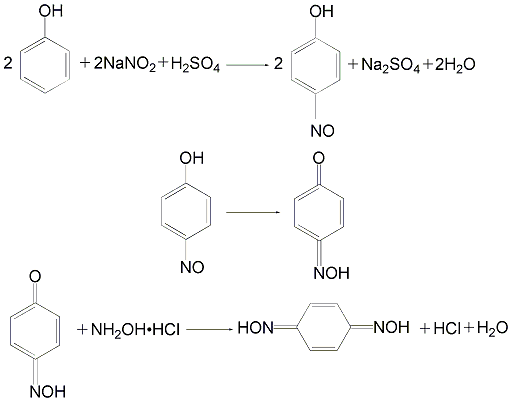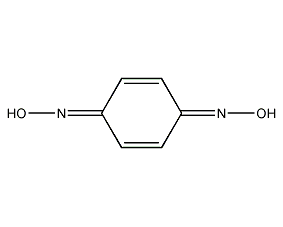p-Benzoquinone dioxime p-Benzoquinone dioxime


Structural formula
| Business number | 02RB |
|---|---|
| Molecular formula | C6H6N2O2 |
| Molecular weight | 138.12 |
| label |
1,4-Benzoquinonedioxime, To quinone dioxime, 1,4-Benzoquinone Dioxime, p-quinone dioxime, Vulcanizing agent, Self-vulcanizing adhesive, Reagents for detecting nickel |
Numbering system
CAS number:105-11-3
MDL number:MFCD00063636
EINECS number:203-271-5
RTECS number:DK4900000
BRN number:2043234
PubChem number:24891555
Physical property data
1. Properties: light yellow needle-like crystals or dark brown powder.
2. Density (g/mL, 20℃): 1.2~1.4
3. Relative vapor density (g/mL, air=1): Undetermined
4. Melting point (ºC): 240℃ (decomposition)
5. Boiling point (ºC, normal pressure): Undetermined
6. Boiling point (ºC, 5.2kPa) : Undetermined
7. Refractive index: Undetermined
8. Flash point (ºC): Undetermined
9. Specific rotation (º): Undetermined
10. Autoignition point or ignition temperature (ºC): Undetermined
11. Vapor pressure (kPa, 25ºC): Undetermined
12 . Saturated vapor pressure (kPa, 60ºC): Undetermined
13. Heat of combustion (KJ/mol): Undetermined
14. Critical temperature (ºC): Undetermined
p>
15. Critical pressure (KPa): Undetermined
16. Log value of oil-water (octanol/water) partition coefficient: Undetermined
17. Explosion upper limit (%, V/V): Undetermined
18. Lower explosion limit (%, V/V): Undetermined
19. Solubility: Easily soluble in ethanol, acetic acid, Ethyl acetate, soluble in hot water, insoluble in cold water, benzene and gasoline.
Toxicological data
None
Ecological data
None
Molecular structure data
1. Molar refractive index: 35.45
2. Molar volume (cm3/mol): 104.4
3. Isotonic specific volume (90.2K ): 282.0
4. Surface tension (dyne/cm): 53.2
5. Dielectric constant:
6. Dipole moment (10-24cm3):
7. Polarizability: 14.05
Compute chemical data
1. Hydrophobic parameter calculation parameters�� value (XlogP): None
2. Number of hydrogen bond donors: 2
3. Number of hydrogen bond acceptors: 4
4. Yes Number of rotational chemical bonds: 1
5. Number of tautomers: 4
6. Topological molecule polar surface area 61.7
7. Number of heavy atoms: 10
8. Surface charge: 0
9. Complexity: 110
10. Number of isotope atoms: 0
11. Determine the number of atomic stereocenters: 0
12. Uncertain number of atomic stereocenters: 0
13. Determine the number of chemical bond stereocenters: 0
14. Number of uncertain chemical bond stereocenters: 0
15. Number of covalent bond units: 1
Properties and stability
Flammable. Toxic, synthetic rubber gloves and dust masks should be worn during operation to prevent skin contact and inhalation, and keep away from open flames and high temperature heat sources.
Storage method
Store airtight in a cool and ventilated place. The shelf life is 12 months, and it can still be used if it passes the re-inspection after expiration. During transportation, prevent rain and exposure, and do not mix storage and transportation with strong oxidants.
Synthesis method
First add 30% sodium hydroxide solution to the reaction kettle, slowly add phenol under stirring to dissolve it in the sodium hydroxide solution. Cool the temperature to 0°C and then add sodium nitrite and 30% sulfuric acid to keep the temperature at 7 to 8°C for reaction, and nitrosophenol crystallizes and precipitates gradually. After stirring for 1 hour, let it stand for filtration, and wash the crystals with water to obtain nitrosophenol. After translocation, it is mixed with hydroxylamine hydrochloride aqueous solution and heated to 70°C for oximation reaction. After the reaction is completed, filter to obtain p-benzoquinonedioxime.

Purpose
This product is used as vulcanizing agent for butyl rubber, natural rubber, styrene-butadiene rubber, and polysulfide “ST” rubber, especially for butyl rubber. Oxidants (such as Pb3O4, PbO2) have an activation effect on it. It is easy to disperse in the rubber material, vulcanizes quickly, and the vulcanized rubber has high elongation strength. The critical temperature is relatively low and there is a tendency to scorch. Adding certain anti-scorch agents (such as phthalic anhydride, anti-scorch agent NA) and accelerators (such as thiurams, thiazoles, dithiocarbamates) can effectively improve operational safety. This product has discoloration and staining properties and is only suitable for dark-colored products. When the accelerator DM is used as the active agent, the scorch resistance is better than that of lead oxide, and the discoloration is also weakened, except for carbon black rubber. When tetrachlorobenzoquinone is used as the active agent, the activation effect is much stronger than that of lead oxide. This product is mainly used to make air bags, water tires, insulation layers of wires and cables, heat-resistant washers, etc. Dosage: 1 to 2 servings. Combined with 10 to 6 parts of lead oxide or 4 to 2 parts of accelerator DM. This product can also be used in self-vulcanizing adhesives and is also a reagent for detecting nickel.
